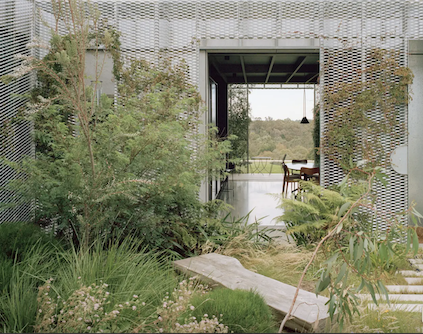A winning connection

One of the most exciting themes in this year’s National Architecture Awards was the way architects and clients are exploring new approaches to living, and ‘Hedge and Arbour House’ by Studio Bright is a standout example.
Guided by the client’s wish to foster a closer connection to nature, the house is designed to be almost entirely enveloped by the landscape.
Forty-six projects earned an award or commendation from a pool of 77 shortlisted entries in the Australian Institute of Architects 2025 National Architecture Awards.
Jury chair and immediate past national president of the Institute Jane Cassidy commented that the projects demonstrate a transition “to sustainable low-operational and embodied carbon; to passive-first, all-electric principles; to local and ethical sourcing; to caring for Country; to regenerative practice and embedded biodiversity, social inclusion and connectedness; to waste minimisation and adaptive reuse and recycling; and away from the excesses of the past.”
“The projects we encountered this year are more than structures: they are systems of care, of connection, of transformation,” she said. “This year we have seen a body of work that is unafraid to ask difficult questions – about equity, climate and care.”
The Robin Boyd Award for Residential Architecture, Houses (New) was given to the ‘Hedge and Arbour House’, which transitions from a thick domestic hedge on a suburban Melbourne street to a swath of native bushland with a creek below. The house itself is wrapped in a galvanised steel-mesh arbour, allowing the landscape to subsume the house almost entirely. Inside, the spaces provide a calming refuge in constant connection to views of the bush landscape beyond.
A similar approach to the natural world is evident in the recipient of the Eleanor Cullis-Hill Award for Residential Architecture, Houses (Alterations and Additions). Designed by John Ellway with Hannah Waring, ‘Niwa House’ reimagines the traditional Queenslander through a lens of Japanese domestic architecture. Drawing on the concept of the niwa – a small, cultivated courtyard – this project introduces a 30-square-metre addition that mediates daily life through architecture, nature and climate. The central courtyard acts as a contemplative heart of the home, allowing light, air and seasonal change to permeate, while promoting spatial calm and environmental response.
The use of fine bronze mesh evokes Japanese screen architecture, delicately filtering light and views while enabling cross-ventilation, rain protection and insect control. The design’s sequencing – through verandahs, garden and gently stepped living spaces – fosters a reflective domestic rhythm reminiscent of traditional Japanese planning.
Sustainability is embedded through passive design, a 12-kilowatt solar array, native planting, water sensitivity and rehabilitated backyard ecology. Landscape by Prandium Studio supports biodiversity and a sense of wildness, reinterpreting suburban gardens as habitats.
A creative approach to multi-family accommodation was awarded the Frederick Romberg Award for Residential Architecture, Multiple Housing. Blok Three Sisters on Stradbroke Island offers accommodation for three sisters and their extended families in the form of three coastal ‘townhouses’ replacing a single-family beach shack on the site which had been enjoyed by the sisters since childhood. This project is about nostalgia manifest in an architecture that facilitates intergenerational living, and the importance of passing on knowledge of place, community, ways of living at the beach and how to be on holiday. The dexterity of its modular construction process provides a clear blueprint of how quality strategic prefabrication can be translated into new modes of construction process in Australia.
The full list of all winners can be found on the Australian Institute of Architects website.
Image: Rory Gardiner